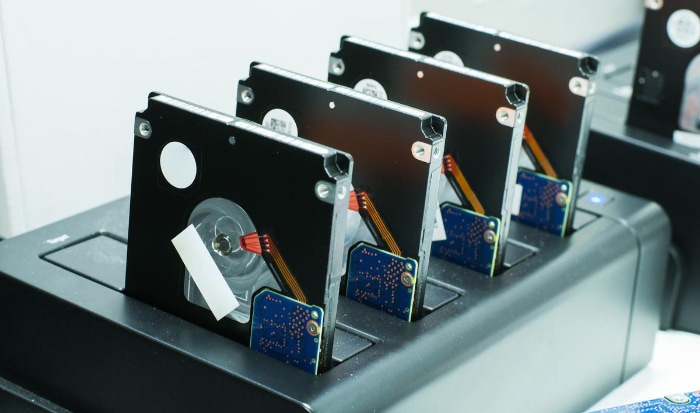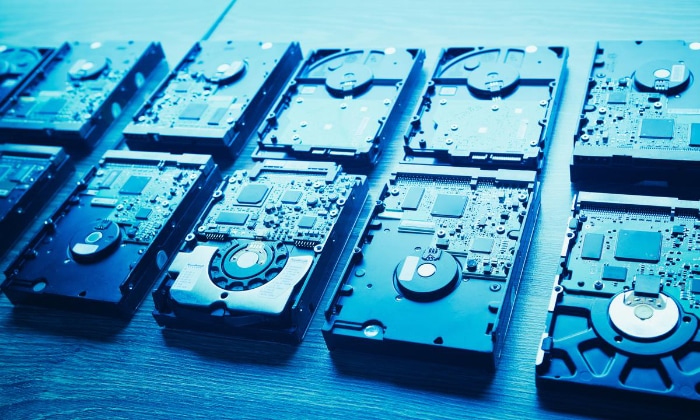What Is Disk Cloning? Basics of Disk-To-Disk Transfer

Disk cloning might sound like a concept straight out of a science fiction movie, but in reality, it’s a crucial technological practice with significant implications for data management and system reliability. Whether you’re looking to upgrade your computer, migrate an entire operating system, or implement a foolproof disaster recovery plan, disk cloning serves as a versatile solution for a myriad of challenges.
Defining Disk Cloning
When it comes to managing digital assets and ensuring data integrity, disk cloning stands as one of the most effective methodologies. This technique entails creating an exact replica of a hard disk drive (HDD) or solid-state drive (SSD), capturing not only files and folders but also the system’s configuration and other attributes.
What Exactly Is Disk Cloning?
Disk cloning involves copying all the contents of one drive to another, making a one-to-one duplicate. This means every file, system setting, and even the hidden system files are transferred to the destination disk.
Unlike a simple file backup, which only copies individual files, disk cloning replicates the entire drive down to every last bit.
Distinction from Disk Imaging
It’s easy to confuse disk cloning with another similar technique known as disk imaging. While both methods aim to secure data and system settings, they do so in different ways.
Disk imaging creates a compressed file, an “image,” which contains the content and structure of a disk. This image can be restored later, but until then, it exists as a single file.
Disk cloning, on the other hand, immediately produces a fully functional duplicate disk that’s ready for immediate use.
Components Involved
In the disk cloning process, there are typically two key components—the source disk and the target disk. The source disk is the one you want to clone, and the target disk is where the clone will be saved.
It’s important to ensure the target disk has enough space to accommodate all the data from the source disk, as well as any additional system files that might not be readily visible.
Essential Technical Steps
- Data Verification: Before initiating the cloning process, it’s important to verify that the source disk is free of errors to avoid cloning corrupted data.
- Data Transfer: This is the core step, where data from the source disk is copied onto the target disk. This can be done using various disk cloning software or command-line utilities.
- Final Validation: After the cloning is complete, a verification process takes place to ensure that the target disk is an exact replica of the source disk.
Types of Disk Cloning
While the concept of disk cloning may seem straightforward, the process comes with its own variations. Depending on your specific needs and the nature of the data involved, different types of disk cloning can be employed.
Sector-by-Sector Cloning
In this approach, every single sector on the source disk is copied to the target disk, regardless of whether it is in use or not. This results in an exact bit-for-bit copy of the original disk.
This method is especially useful when you want to recover not just existing files, but also deleted or lost data that could be lurking in unused sectors.
When to Use Sector-by-Sector Cloning
Sector-by-sector cloning is most beneficial for forensic data recovery and analysis. By preserving even the unused sectors, you have a comprehensive clone that can be essential for detailed examinations or data restoration efforts.
File-by-File Cloning
This method focuses on copying only the files and directories that are currently in use, skipping the empty or unused sectors. File-by-file cloning is quicker and requires less storage space compared to sector-by-sector cloning. However, it doesn’t capture deleted or lost files that might still be recoverable from unused sectors.
When to Use File-by-File Cloning
If you’re primarily concerned with transferring current files and system settings, without the need for capturing deleted data, this method serves well. It’s generally employed for regular backup routines and simple data migration tasks.
Partition Cloning
In some cases, you might not want to clone the entire disk but just specific partitions. Partition cloning allows for the duplication of individual partitions, instead of the whole disk. This provides more control over what is cloned and is particularly useful if you have a multi-partition setup.
When to Use Partition Cloning
Partition cloning is effective when you need to copy or backup specific sections of your drive, such as a dedicated partition for a certain type of data or application. It’s often utilized in enterprise environments where partitions are configured for specialized purposes.
Why Disk Cloning is Important
The importance of disk cloning often becomes evident when faced with challenges such as data loss, system migration, or disaster recovery. This practice extends beyond simple data backup, offering comprehensive solutions to a range of issues.
Data Backup
One of the most fundamental uses of disk cloning is for data backup. Unlike traditional backup methods that only copy specific files or folders, disk cloning ensures that nothing is left behind.
This includes system files, settings, and even the configuration of the disk itself.
Comprehensive Solution
Disk cloning provides a more complete backup option compared to other methods. With a cloned disk, restoring your system is as simple as swapping drives, thereby significantly reducing downtime.
System Migration
Migrating your operating system and all your files to a new computer or hard drive can be a cumbersome process. Disk cloning simplifies this by creating an exact replica of your old system on the new hardware.
Streamlined Transition
Disk cloning makes it much easier to move from an older machine to a newer one, or from a smaller hard drive to a larger one, without the hassle of reinstalling the operating system and all your programs.
Disaster Recovery
In scenarios where systems need to be restored as quickly as possible, such as after a catastrophic hardware failure or a malware attack, having a cloned disk ready can be a lifesaver.
Quick Restoration
In the case of a disaster, you can swiftly replace the affected drive with its clone, ensuring minimal interruption to operations. This is especially crucial in business settings where downtime can be costly.
Flexibility and Portability
Disk cloning allows you to create portable versions of your entire system. This is particularly useful if you need to deploy the same setup across multiple machines, as is common in educational and enterprise environments.
Scalable Deployment
With disk clones, setting up multiple computers becomes a much less complicated task. You can easily clone a single, well-configured system to multiple drives, enabling quick and uniform deployment across different hardware platforms.
Advantages of Disk Cloning

Disk cloning brings a plethora of benefits to the table, especially when considering its role in data management and system reliability. While its advantages may vary depending on the specific use case, some key benefits make it a compelling choice for both personal and organizational settings.
Convenience
One of the most striking benefits of disk cloning is its convenience. Rather than manually selecting which files to back up, disk cloning automates the process by creating a complete copy of your drive.
Time and Effort Savings
The automated nature of disk cloning significantly reduces the time and effort required to secure all your data and system settings. Once set up, the process can often run in the background without requiring user intervention.
Consistency
Disk cloning ensures that every bit of data is copied, which leads to a highly consistent state between the source and the target disk. This level of consistency is hard to achieve through other means.
Guaranteed System State
When you clone a disk, you are ensuring that the target disk is in the exact same state as the source disk. This is particularly useful for troubleshooting, as it allows you to work with a system that is a precise duplicate of the original.
Immediate Usability
Unlike disk imaging, which requires you to restore the image to a drive before it becomes usable, a cloned disk is immediately operational. This makes it an ideal solution for quick system swaps.
Reduced Downtime
The immediate usability of a cloned disk translates to reduced downtime, whether you’re dealing with system maintenance, hardware upgrades, or emergency recoveries.
Versatility
Disk cloning is versatile in that it can be used for a variety of purposes, such as data backup, system migration, and disaster recovery. This multipurpose nature makes it a valuable tool in any tech toolkit.
Multiple Applications
Whether you’re a casual user wanting to upgrade your hard drive or an IT professional responsible for maintaining a network of computers, the versatility of disk cloning allows it to adapt to a multitude of scenarios.
Cost-Efficiency
Given that disk cloning can serve multiple needs—from backup to system migration—it offers a cost-efficient solution for data management and system maintenance.
Economic Benefits
By consolidating various functions into one process, disk cloning can reduce the need for multiple software solutions, leading to financial savings in the long run.
Disadvantages of Disk Cloning
While disk cloning offers a multitude of advantages, it’s essential to consider its limitations as well. By acknowledging these drawbacks, you can make a more informed decision about when and how to use disk cloning effectively.
Storage Requirements
One of the major limitations of disk cloning is the amount of storage space it demands, especially for sector-by-sector cloning, which replicates every bit of data on the drive, including unused sectors.
High Storage Costs
The need for ample storage can translate to increased costs, particularly if you are dealing with multiple drives or large-capacity disks. This is an important factor to consider when planning your disk cloning strategy.
Complexity
Although disk cloning can simplify many tasks, the process itself can be complex, especially for those who are not tech-savvy.
Potential for User Error
The complexity means that there’s a higher potential for user error. A simple mistake in selecting the source and target drives can result in data loss or corruption.
Time Consumption
Disk cloning can be a time-consuming process, particularly if the disk has a large amount of data. Sector-by-sector cloning, which is more comprehensive, usually takes even more time.
Delays in Workflow
The time required to complete a disk cloning operation can introduce delays, especially in organizational settings where quick data access is essential for maintaining workflow continuity.
Compatibility Issues
Disk cloning might involve hardware and software compatibility challenges. Not all disk cloning software supports every file system or operating system, which can limit your options.
Limited Usability
Compatibility issues can make it difficult to clone disks across different platforms or to switch from one cloning software to another, restricting the overall usability of the technique.
Data Privacy Risks
When creating exact replicas of disks, there’s a risk of unintentionally copying sensitive or confidential information. If the cloned disk is not stored securely, it can lead to data breaches.
Security Implications
The risk to data privacy becomes even more significant in corporate or multi-user environments. Mishandling a cloned disk containing sensitive data can have severe security and legal ramifications.
Conclusion
Disk cloning serves as a robust method for data backup, system migration, and disaster recovery, offering a range of advantages such as convenience, consistency, immediate usability, versatility, and cost-efficiency. However, it’s essential to weigh these benefits against the inherent disadvantages, which include substantial storage requirements, complexity, time consumption, compatibility issues, and data privacy risks.
By comprehensively evaluating both the pros and cons, you can make a well-informed decision about employing disk cloning for your specific needs, whether you’re an individual user or managing an extensive network of computers. This balanced approach will help you leverage the potential of disk cloning while mitigating its limitations, ultimately contributing to a more effective and secure data management strategy.


